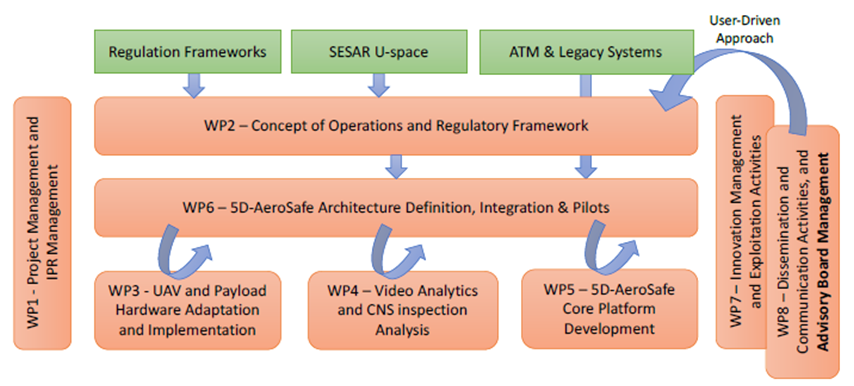
- To coordinate all the management activities of the project.
- To coordinate the contractual, financial and legal activities.
- To interface with the EU Commission (EC), H2020 Community and other External bodies.
- To set-up communication channels between partners and ensure the overall quality of the project.
- To ensure the conformance of the final results to initial scope and goals of the project.
- To monitor the project status and progress through close interaction with partners.
- To prepare and maintain a framework for the production and delivery of project documents.
- To prepare and maintain the internal wikis, communication tools and code repositories.
- To perform a risk analysis and make corrective decisions if needed.
- To organise project’s internal events such as PSC meetings, UAB meetings, and reviews
- To provide the uses cases and scenario definitions for the pilots, forming the concept of operations of the system (CONOPS);
- To determine the list of requirements and associated KPIs for the 5D-AeroSafe solution from the users’ perspective;
- To investigate adherence to the relevant regulatory frameworks (ICAO Annex 10, ΙCAO Doc 8071, NPA 2017-05) and its application to the resulting system and to examine potential ethical/legal aspects for implementing the UTMS at airports.
- Provide 3D reconstruction of the runways/taxiways and water runways geometry.
- Identify attributes such as lane markings, signs, obstacles, etc.
- Detect static and dynamic objects in the scene.
- Classify static and dynamic object types.
- To elaborate the system architecture, based on the end-users expectations and the optimised technical solutions.
- To prepare and perform the overall system integration,
- The integration is performed step by step (each time a component is ready and validated). There will be two versions of 5D-AeroSafe system (V1 ready at M25 and V2 ready at M30). The integration is performed in 3 steps, i.e. (1) integration of UAVs with the GGCS; (2) integration of the GGCS with the UTM platform; (3) integration of the UTM platform with the legacy systems of the airport to exchange information about the airport facilities and flights.
- To plan and to prepare the pilots in the various locations
- To perform the tests and trials during the pilots.
- To assess the results from operational and technical points of view
- Formulate a combined exploitation plan, which will include individual exploitation plans and a road map to take the 5D-AeroSafe solution to market;
- Develop a business plan which will guide the commercialisation of the project results;
- Monitor closely the technologies and market in order to keep abreast of the technological developments in the aviation domain, thus ensuring the project developments always keep in line with current trends and needs.
- Raise awareness regarding the project and its outcomes to relevant stakeholders, policymakers and the research community by establishing a detailed dissemination and communication plan.
- Promote the project dissemination and communication efforts and make results available to potential users, policy makers, research community, and other stakeholders.
- Facilitate the networking and mutual communication both to the scientific community and the public.
- Facilitate the engagement of the User Advisory Board members within the project.
- Organise project events to engage relevant stakeholders and establish closer ties with them.
- Produce dissemination and communications materials.
- Produce high-quality videos document project trials, including interviews with key experts.
- Identify scientific and industrial venues of dissemination and communication.
Estimated Dates
|
Phase |
WP |
Est. Due Date |
|
Phase 0 -Planning, Management |
WP1- Project Management and IPR Management |
31 May 2023 |
|
Phase 1- Requirements, Regulations, Concept of Operations: |
WP2- Concept of Operations and Regulatory Framework |
28 Feb 2021 |
|
Phase 2- Development and Testing |
WP3 -UAV and Payload Hardware Adaptation and Implementation |
30 Nov 2022 |
|
WP4- Video Analytics and CNS inspection Analysis |
28 Feb 2022 |
|
|
WP5- Core 5D-AeroSafe Platform Development |
28 Feb 2023 |
|
|
Phase 3- Demonstration and Validation |
WP6- 5D-AeroSafe Architecture Definition, Integration and Pilots |
31 May 2023 |
|
Phase 4- Dissemination and Communication Activities, Innovation Management and Exploitation Activities |
WP7- Innovation Management and Exploitation Activities |
31 May 2023 |
|
WP8- Dissemination and Communication Activities, and User Advisory Board Management |
30 Apr 2023 |
